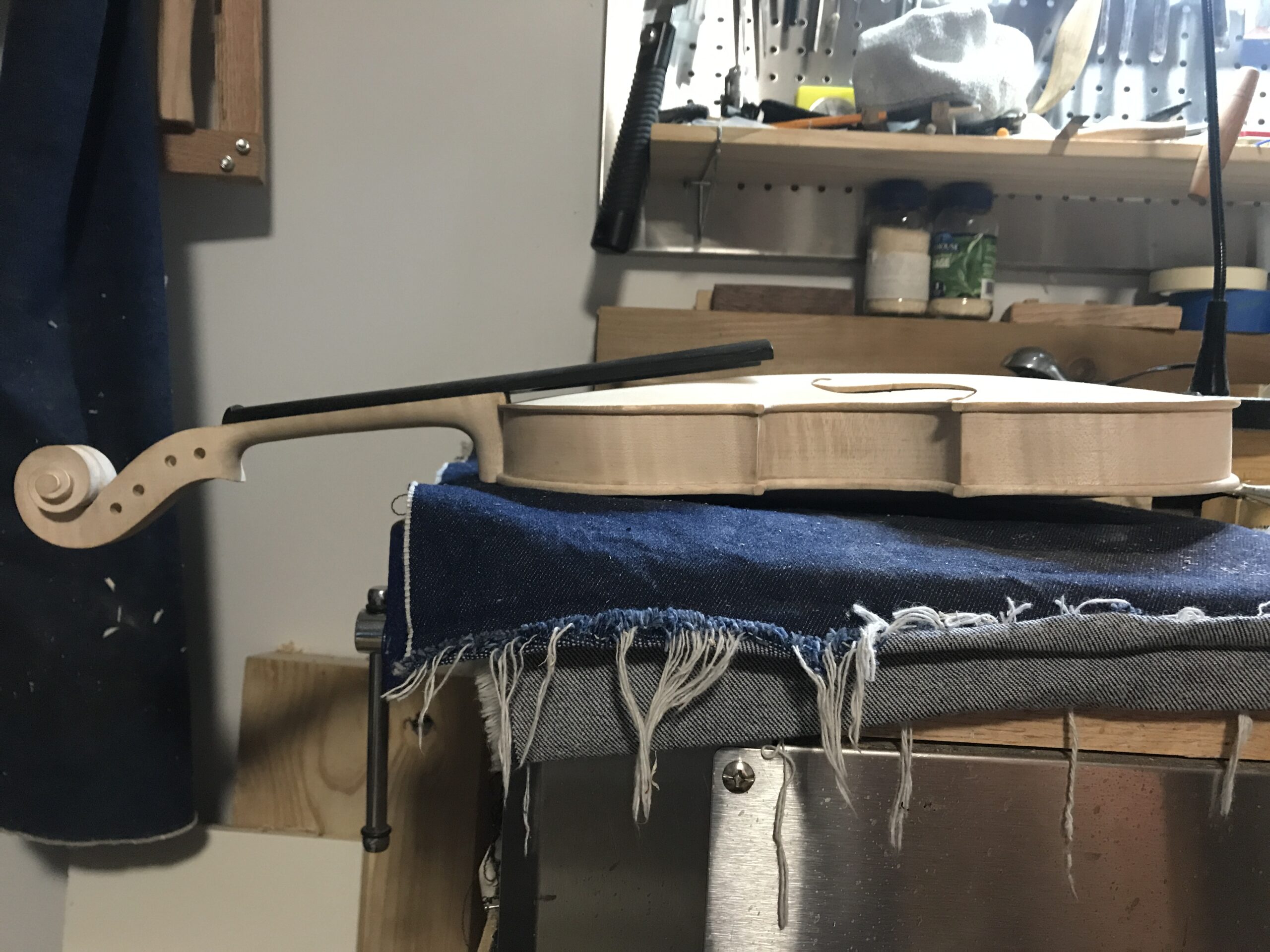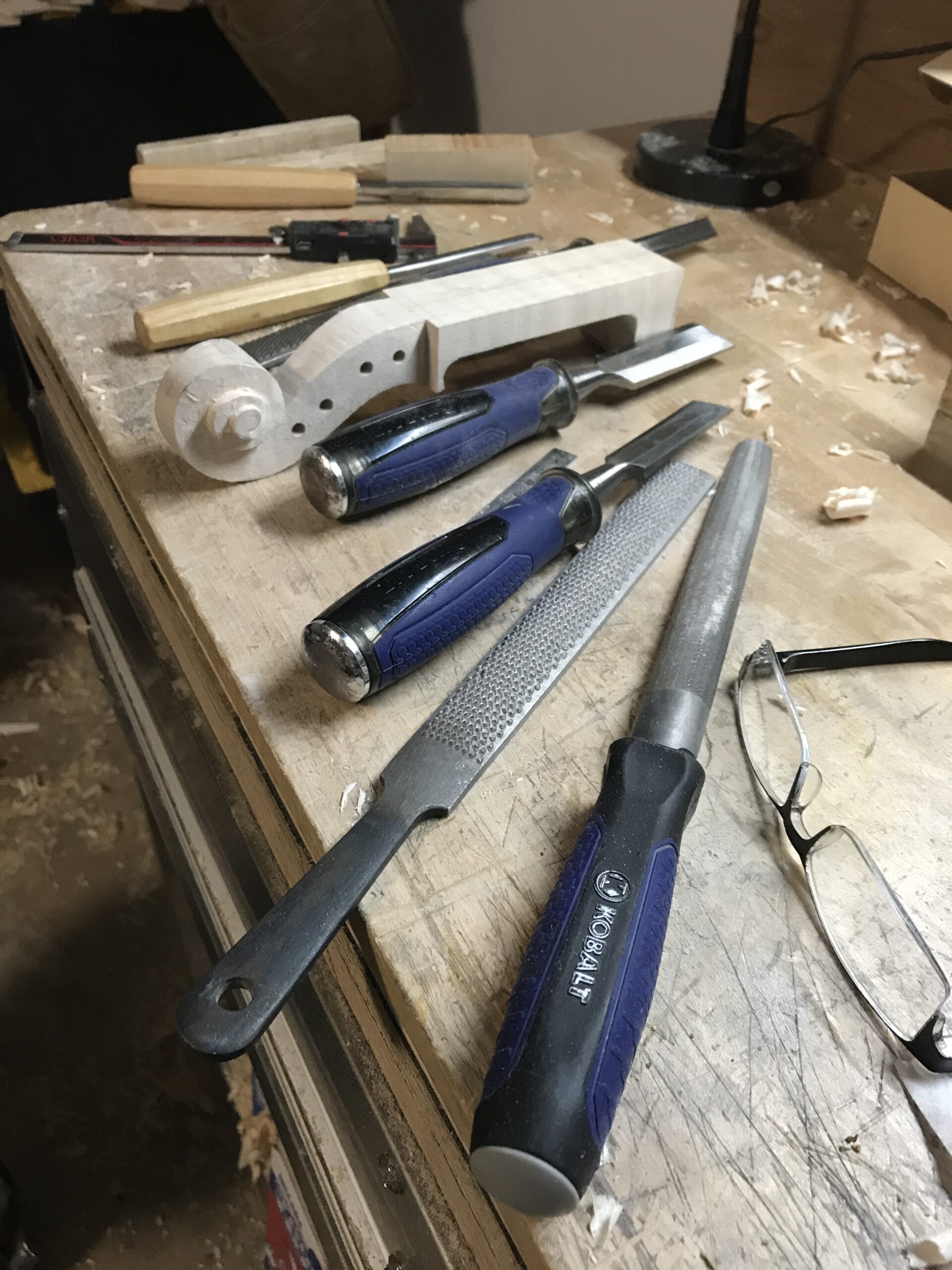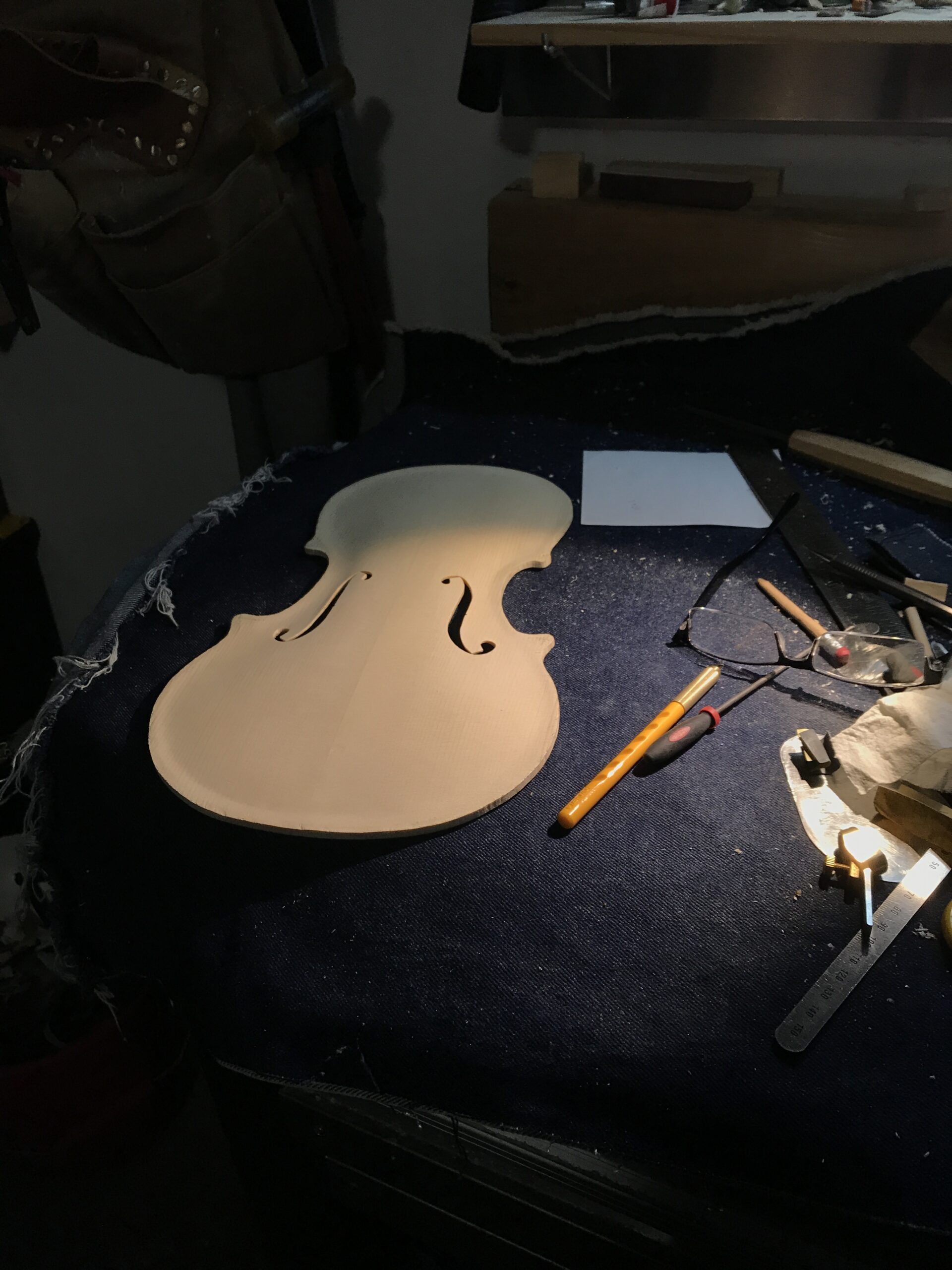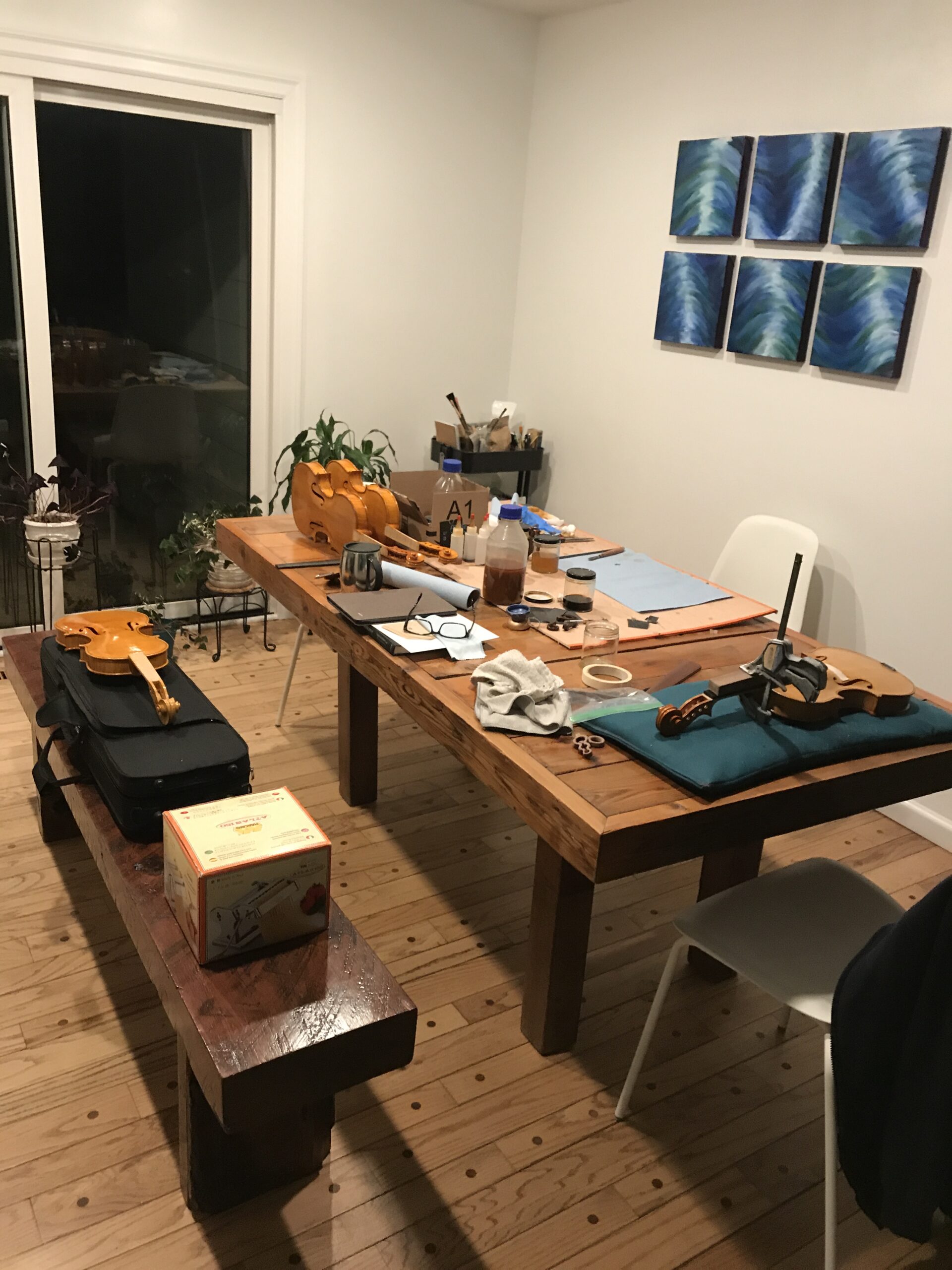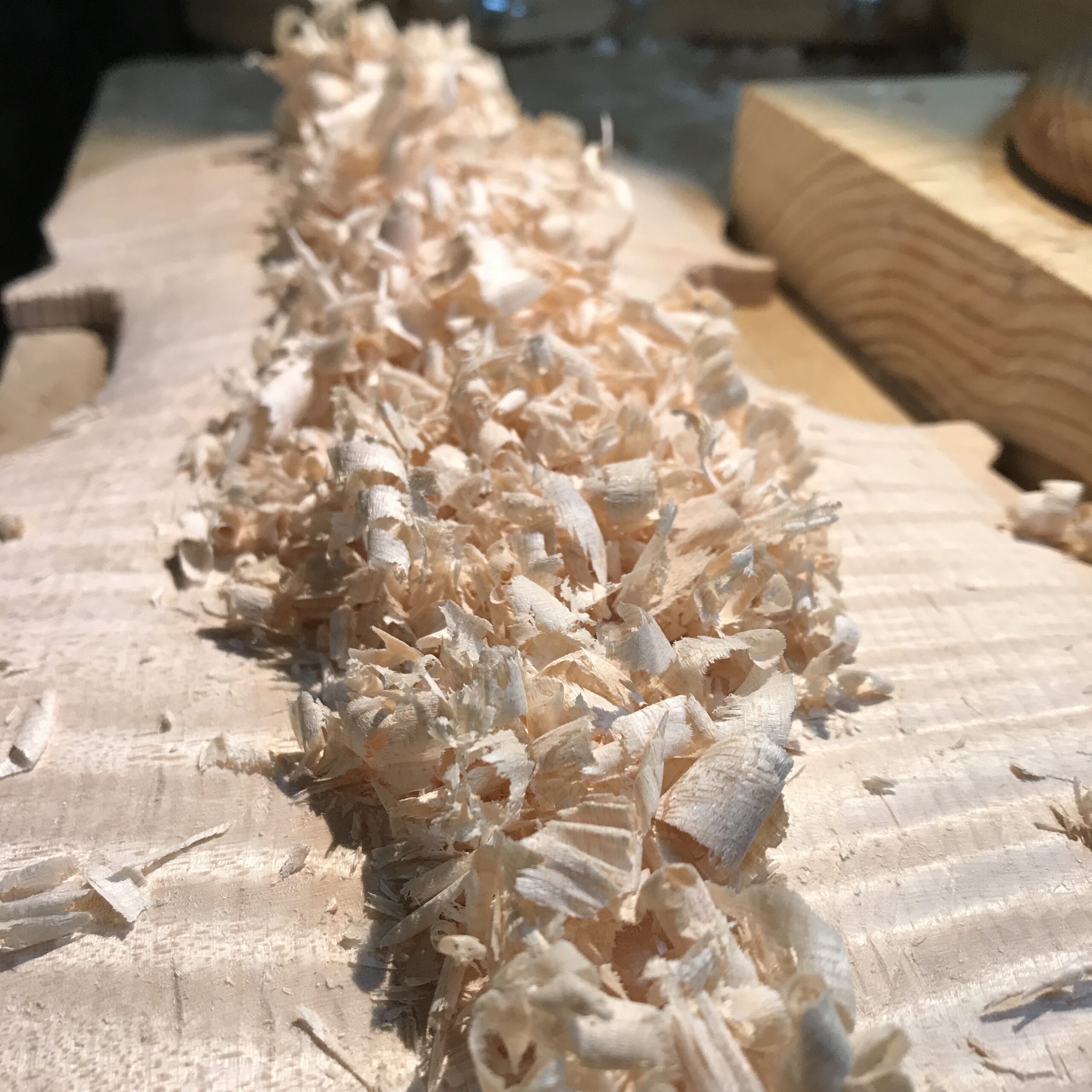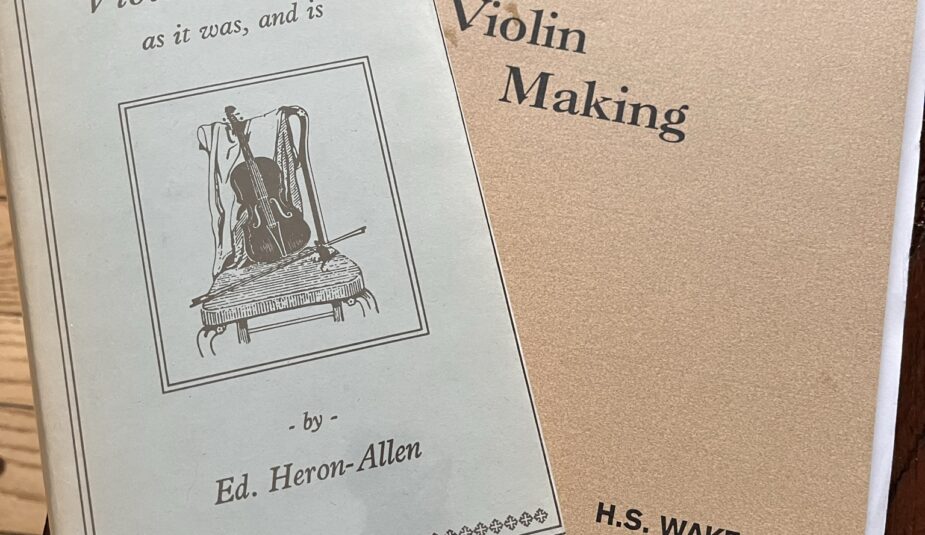Just appreciating the view.
Blog
The scroll begins to show
I have my own style of scrolls. I feel like my style is more Brescian and less Cremona. I want my scrolls to suggest a sheet of music rolled up transforming into a peg box, neck then shoulder. Besides, I don’t do direct copies, so I have room for some of my own style. View “Verity” for a good example. If you look at my older violins, you can definitely see my scroll work evolve. I feel much more confident now. Any way, check’em out for yourself.
A new f hole
Every time I work on f holes I have to sit back and stare at them. I work on my f-holes in about three sessions. The one thing I don’t want to do is cut away too much because I lost focus. No, I prefer roughing it in, cleaning it up, and then adding some style.
Violin Making Journey – Reminiscing when my old violins where new
I was showing off some old pics of my violin making journey and this one really stood out. I remember when these violins were keeping me super busy. In the picture, I have a neck being set and three violins being varnished. It was a super cool and learning time.
It’s amazing to think, “I made these“. I remember when I started my violin making journey I didn’t imagine having four violins on a table and working on them all at once. It just wasn’t in my vision. Fortunately, life didn’t care about my small vision and instead handed me a more memorable experience. This picture really is a reflection of the gratitude I feel for what I have the ability and resources to do with my life.
I reflect on my violin making journey routinely. In the evenings after I wrap up my work, I find myself examining what I did for the day and what I can do better. For me, it is a time to write some notes about what I did, what I did well, what I did poorly and what I want to do next time. Every so often, I open my notebook and read what I wrote and consider where I am and how far I have come. The process of documenting my successes and failures helps me know what to focus on next.
I find it comforting to know I don’t have to come back to every note I wrote for every violin. I consider myself a decent student who learns a lesson and then applies the lesson going forward. Sometimes my notes are facts like “finished 5th coat”, “cut purfling”. These little tidbits help me determine how fast or how much time I am spending on each step of the making process. Others are “go slower when doing corner purfling”, “set aside for the evening before gluing ______”. The one thing they have in common, is the notes are just for me. My wins, defeats, encouragements and facts. They may not tell the whole journey but they sure to remind me where I came from and where I’m going. Hope to see you here in my shop!
Luthier of Note: If you are interested in some great violin (almost ASMR style) makers, I suggest you check out Davide Sora. I can’t get enough. He writes his notes and info in both Italian and English. Happy watching. 🙂
Fun with wood shavings
Thousands and thousands of little wood shavings. Every now and then I have to stop to look at the shavings. This stuff makes great wood tinder. It also makes for cool pictures.
There is a magical thing that happens when an artist takes away something from raw material to create something new. Violin making is no different. There must be a tens thousand little cuts that go into a making violin. Continuously, the work bench needs to be swept off and the floor swept up.
If you watch YouTube videos of violin makers you will see a trait common between most of them. Breathing. Not just breathing but consciously breathing. I sometimes wonder if they even realize they are consciously breathing as a part of the work. What do I mean? Well, when cutting away material with a gouge wood will often stay on the gouge or in the way of the next cut. I don’t have time to take my hand off he gouge and wipe away the wood chips. Instead, I exhale a puff of air to blow away the chip(s), take a relaxed breath and make another cut.
It took me a while to catch on to what was going on. I saw other violin makers doing it and then realized I was doing it. Now, the act of breathing has become part of the routine when paring away wood. The rhythm is peaceful and focusing. Now, when I find myself engaged with a task and I start to feel a little strained or anxious about a task; I stand up straight, do a quick cleansing exhale (puff), re-engage the proper posture and cut away.
Fun note on wood shavings
When working on the top or back, I can easily generate enough shavings to fill a five gallon bucket. The contents are then deposited into my fire pit for later enjoyment. I think it would be cool to reuse them with epoxy and do some custom lathe work. Hit me up, I’ll ship wood shavings, too.
Why is choosing a violin varnish so hard to get right?
The question “what varnish should I use” and “what is the best to finish a stringed instrument” is impossible to answer correctly. Every maker and amateur researcher seems to have an opinion on oil varnish versus spirit varnish and what the ingredients to use. Of all the things people agree and disagree upon when it comes to violin making, violin varnish is one where they deem you a fool or a maven and there isn’t much room in between.
Keep in mind as I discuss this topic, there are people out there who think the sound of Cremona violins sound so good because of the varnish used. I don’t believe an instrument sounds great because of varnish. The construction, wood and varnish together make a violin. This idea though is pervasive and I use the knowledge to weed out the bad info from the worst. What’s left is a hodge podge of ideas, formulas, over the counter options and hair pulling commentary.
Many instrument makers are trying to find the answer to a question that has no answer. What was the old recipe in use in Cremona between 1600 and 1750. There is no one complete and authoritative written answer. Some recipes have been recorded before and around the those times but I can’t find anywhere where any consensus of violin making experts think those recipes were used. Many think the varnish guild did their thing and kept luthiers and woods craftsmen beholden to them. Many believe the old makers used magic resins. Many believe some crazy stuff. There is a information and records from the 15, 16 and 17 centuries, however finding any real discernible and undeniable truth seems elusive. No one source is “the truth” and all the sources together make the top clear as mud.
I’ve given up finding the best varnish but I come back to the subject each time I prepare to varnish a violin. I haven’t read or seen anything lately to persuade me from my current formula. What is my formula? Spirit varnish. It was used in old instruments, made with 100% natural ingredients and I don’t have to cook oil or buy it from someone. The formula I use is based on two violin makers whose work I respect. One of the violin makers uses spirit varnish exclusively and the other only uses it on lower end violins. What’s interesting the one using spirit varnish sells their violins above 5 digits and the other uses oil on their master violins which goes for 5 digits and above, too.
I choose to follow makers I trust and in the end, if you buy one of my violins you will get a spirit varnished violin. I’m not changing my formula for some time. I can make violins any variation of red, brown and yellow. Besides, would you rather have someone make their violin varnish by selecting the best quality resins, mastics and shellac; or, someone who buys it over the counter or via the internet? I’ve made my choice.
While varnish is convoluted and complex topic, what till I write about the “ground” that goes under the varnish. You guessed it; there more items and combinations you can put on wood and few agree on anything. Maybe this disagreeing is the magic of making. Only the maker gets to decide what works for them.
For you, if you are a maker, how did you settle on a violin varnish? Do you vary it?
The picture in this post was two books I reviewed last night that inspired this post. I did get some new ideas to try, but I’m a long way off before I change a good thing..
